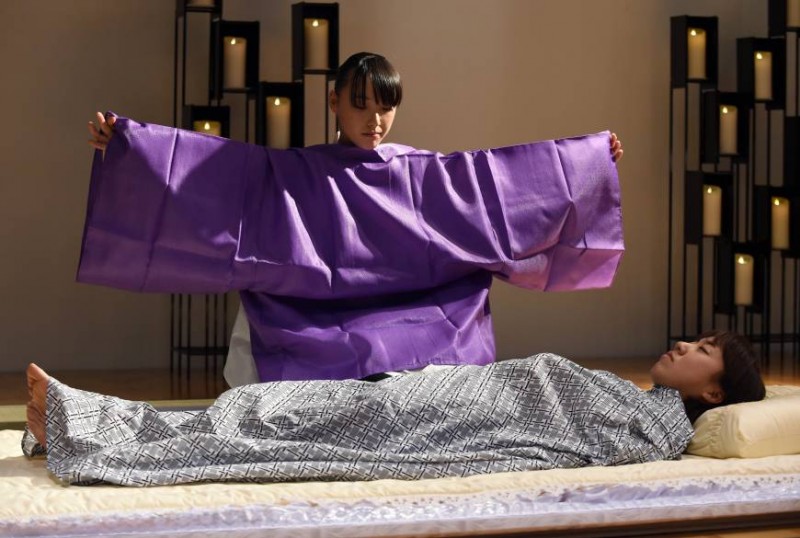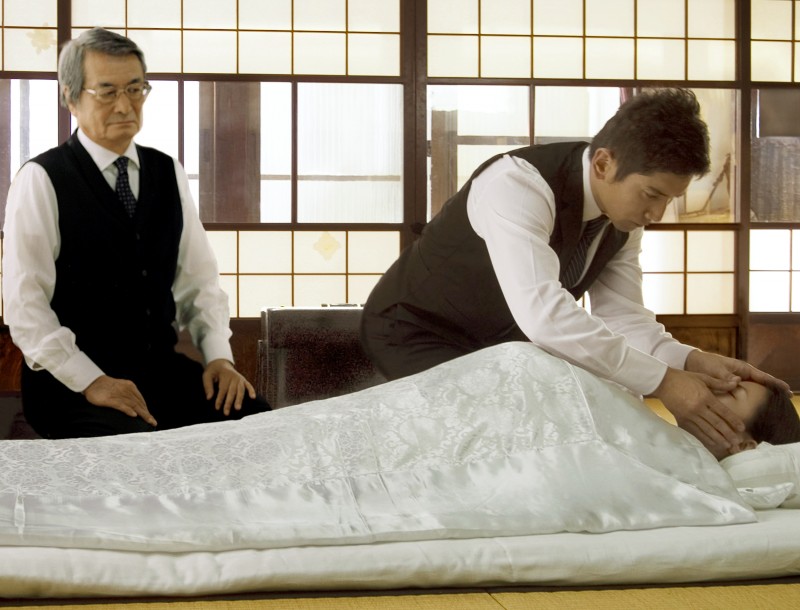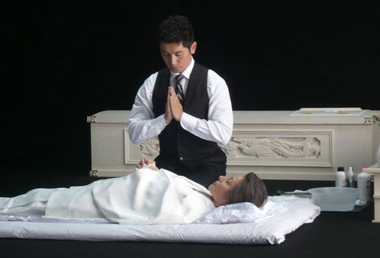A timely article recently appeared in the Japan Times about a subject which will be familiar to anyone who has seen Okuribito (Departures), the 2009 Oscar-winning film about Japan’s special funeral services. The care and sensitivity with which the deceased are handled speak to basic Shinto values of purity, reverence and meticulousness. (For the original article, see here.)

Sayuri Takahashi performs her skills in nokan — preparation of the dead before cremation — during a contest at the Life Ending Industry Expo in Tokyo on Tuesday. More than 200 companies doing businesses related to the end of life, such as funerals, are participating in the three-day exhibition. | AFP-JIJI
Japan’s death specialists converge at inaugural Life Ending Industry Expo
AFP-JIJI DEC 9, 2015
Specialists in the fading profession of preparing bodies for funeral and cremation gave a rare glimpse of their skills at the opening of a Tokyo exhibition focused on the business of death and dying.
Practitioners of nokan — translated as “encoffinment” — took part in what organizers said was Japan’s first contest to demonstrate their techniques, as a pianist and a guitarist played peaceful, relaxing music.
Over 15 minutes, the contestants demonstrated their skill on Tuesday in dressing live models who laid still on a futon. Sayuri Takahashi knelt gracefully before a motionless female figure on the floor, gently maneuvering the arms and legs to dress her in a shirt, slacks and socks, with the light of artificial candles flickering behind.

PR shot from the film Okuribito
The partially clothed model was covered with a robe to hide exposed skin, the favored way of dressing the dead to maintain modesty when family members are watching.
The competition was part of the inaugural Life Ending Industry Expo, which has attracted more than 200 companies in the business of death. The expo runs through Thursday.
The craft of the specialists, who are known as nokanshi, is declining in bigger cities but remains fairly common in rural areas. The work overlaps somewhat with that of morticians in Western countries, though in Japan embalming is rare and wakes and funerals are still sometimes held in the family home.
It came to worldwide attention in 2009 when the film Okuribito (“Departures”) won the Oscar for best foreign-language film for its depiction of an out-of-work cellist who becomes a nokanshi in small-town Japan.
“We wanted the public to know more about nokanshi as there weren’t enough specialists after the 2011 disaster,” said competition organizer Koki Kimura, referring to the Great East Japan Earthquake and tsunami in which more than 15,000 people died.
A panel of three judges examined not only how well the models were dressed but also how gracefully the nokanshi completed the process. “The kindness and politeness toward the family of the deceased combined with efficiency are key,” said Shinji Kimura, one of the judges and an adviser to the lead actor in Okuribito. “We want to do our best for the final departure of the deceased,” said Kimura, who has 30 years of experience as a nokanshi. “So it should not be mechanical.”
Takahashi, the 27-year-old winner who was awarded a trophy and an undisclosed sum, said she started her job three years ago after learning about the profession following a death in her family where the body was tended to by a nokanshi.
“My relative’s face looked peaceful,” she said after the contest, adding that the Oscar-winning movie also inspired her choice. “I’m most happy when the family of the deceased tell me they’re grateful for what I did,” she said.
**********************
The full series of Shinto death postings are as follows:
Part 1: Overview
Part 2: Washing
Part 3: Offerings
Part 4: The Coffin
Part 5: Home rites
Part 6: The Wake
Part 7: Spirit Transfer
Part 8: Funeral rite
Part 9: Funeral procession
Part 10: Memorial rites
Part 11: Posthumous names
Part 12: Taboos
Part 13: Graves and afterlife
Part 14: Impurity
Part 15: Summing up


Leave a Reply